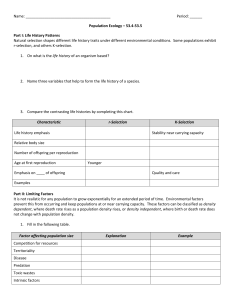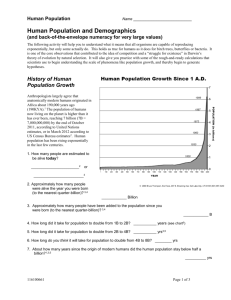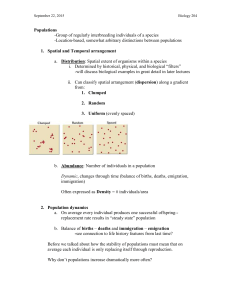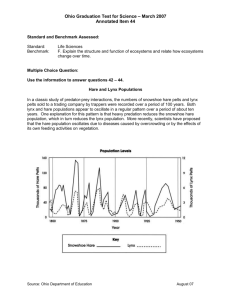Chapter 55
advertisement
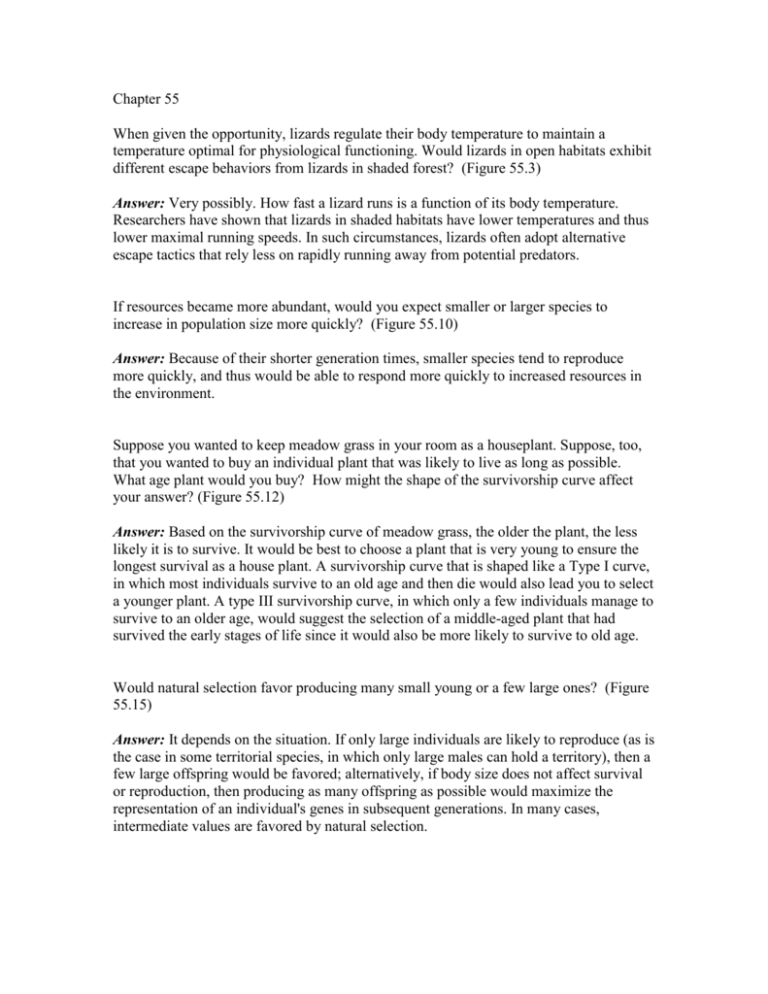
Chapter 55 When given the opportunity, lizards regulate their body temperature to maintain a temperature optimal for physiological functioning. Would lizards in open habitats exhibit different escape behaviors from lizards in shaded forest? (Figure 55.3) Answer: Very possibly. How fast a lizard runs is a function of its body temperature. Researchers have shown that lizards in shaded habitats have lower temperatures and thus lower maximal running speeds. In such circumstances, lizards often adopt alternative escape tactics that rely less on rapidly running away from potential predators. If resources became more abundant, would you expect smaller or larger species to increase in population size more quickly? (Figure 55.10) Answer: Because of their shorter generation times, smaller species tend to reproduce more quickly, and thus would be able to respond more quickly to increased resources in the environment. Suppose you wanted to keep meadow grass in your room as a houseplant. Suppose, too, that you wanted to buy an individual plant that was likely to live as long as possible. What age plant would you buy? How might the shape of the survivorship curve affect your answer? (Figure 55.12) Answer: Based on the survivorship curve of meadow grass, the older the plant, the less likely it is to survive. It would be best to choose a plant that is very young to ensure the longest survival as a house plant. A survivorship curve that is shaped like a Type I curve, in which most individuals survive to an old age and then die would also lead you to select a younger plant. A type III survivorship curve, in which only a few individuals manage to survive to an older age, would suggest the selection of a middle-aged plant that had survived the early stages of life since it would also be more likely to survive to old age. Would natural selection favor producing many small young or a few large ones? (Figure 55.15) Answer: It depends on the situation. If only large individuals are likely to reproduce (as is the case in some territorial species, in which only large males can hold a territory), then a few large offspring would be favored; alternatively, if body size does not affect survival or reproduction, then producing as many offspring as possible would maximize the representation of an individual's genes in subsequent generations. In many cases, intermediate values are favored by natural selection. Why does the growth rate converge on zero? (Figure 55.18) Answer: Because when the population is below carrying capacity, the population increases in size. As it approaches the carrying capacity, growth rate slows down either from increased death rates, decreased birthrates, or both, becoming zero as the population hits the carrying capacity. Similarly, populations well above the carrying capacity will experience large decreases in growth rate, resulting either from low birthrates or high death rates, that also approach zero as the population hits the carrying capacity. Why might birthrates be density-dependent? (Figure 55.20) Answer: There are many possible reasons. Perhaps resources become limited, so that females are not able to produce as many offspring. Another possibility is that space is limited so that, at higher populations, individuals spend more time in interactions with other individuals and squander energy that otherwise could be invested in producing and raising more young. What would happen if researchers supplemented the food available to the birds? (Figure 55.21) Answer: The answer depends on whether food is the factor regulating population size. If it is, then the number of young produced at a given population size would increase and the juvenile mortality rate would decrease. However, if other factors, such as the availability of water or predators, regulated population size, then food supplementation might have no effect. Suppose experimenters artificially kept the hare population at a high and constant level; what would happen to the lynx population? Conversely, if experimenters artificially kept the lynx population at a high and constant level, what would happen to the hare population? (Figure 55.24) Answer: If hare population levels were kept high, then we would expect lynx populations to stay high as well because lynx populations respond to food availability. If lynx populations were maintained at a high level, we would expect hare populations to remain low because increased reproduction of hares would lead to increased food for the lynxes. Based on what we have learned about population growth, what do you predict will happen to human population size? (Figure 55.25) Answer: If human populations are regulated by density-dependent factors, then as the population approaches the carrying capacity, either birthrates will decrease or death rates will increase, or both. If populations are regulated by density-independent factors, then if environmental conditions change, then either both rates will decline, death rates will increase, or both. What will the population distributions look like in 20 years? (Figure 55.27) Answer: The answer depends on whether age-specific birth and death rates stay unchanged. If they do, then the Swedish distribution would remain about the same. By contrast, because birthrates are far outstripping death rates, the Kenyan distribution will become increasingly unbalanced as the bulge of young individuals enter their reproductive years and start producing even more offspring. Which is a more important cause of resource depletion, overpopulation or overconsumption? (Figure 55.29) Answer: Both are important causes and the relative importance of the two depends on which resource we are discussing. One thing is clear: The world cannot support its current population size if everyone lived at the level of resource consumption of people in the United States.
